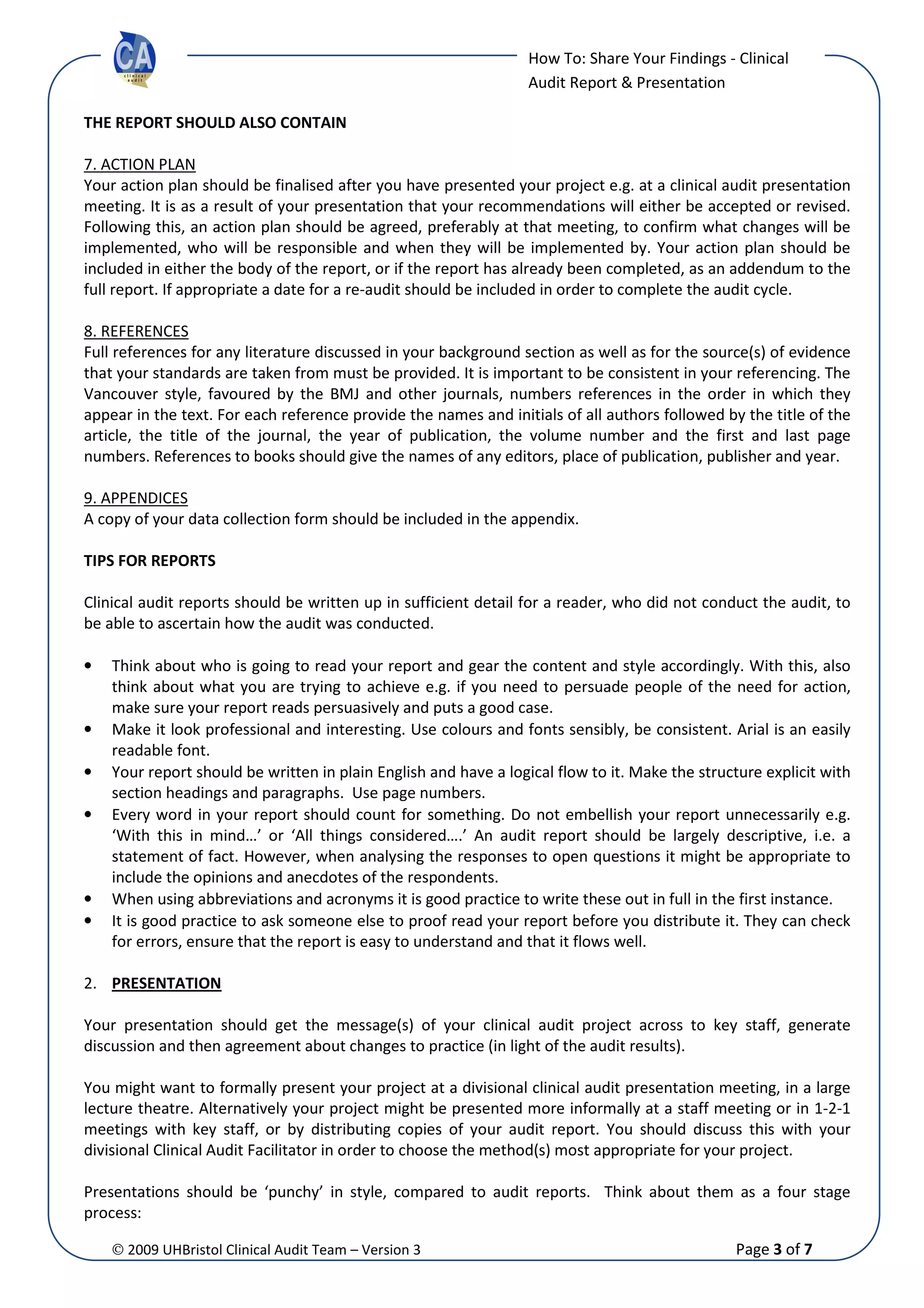This document provides guidance on writing clinical audit reports and designing presentations to share audit results. It recommends including sections on the background, aim, methodology, results, conclusions, and action plan. The report acts as an official record and should include enough detail for someone not involved in the audit to understand how it was conducted. Presentations should get the key messages across and generate discussion to agree on practice changes. Both reports and presentations should maintain confidentiality and not identify individual healthcare staff.






![© 2009 UHBristol Clinical Audit Team – Version 3 Page 7 of 7
How To: Share Your Findings - Clinical
Audit Report & Presentation
CONTACT DETAILS/ USEFUL INFORMATION
CLINICAL AUDIT
• The UHBristol Clinical Audit website is available [online] via: http://www.uhbristol.nhs.uk/healthcare-
professionals/clinical-audit.html
• Contact details for the UHBristol Clinical Audit Team are available from the Clinical Audit Central
Office or [online] via: http://www.uhbristol.nhs.uk/healthcare-professionals/clinical-
audit/contacts.html
• The full range of UHBristol ‘How To’ guides are available [online] via:
http://www.uhbristol.nhs.uk/healthcare-professionals/clinical-audit/how-to-guides.html
• A copy of the UHBristol Proposal Form, Presentation Template, Report Template, Summary Form,
and Action Form are available [online] via: http://www.uhbristol.nhs.uk/healthcare-
professionals/clinical-audit/doing-projects-at-ubht.html
• The UHBristol Clinical Audit Central Office can be contacted on tel. (0117) 342 3614 or e-mail:
stuart.metcalfe@uhbristol.nhs.uk
• Clinical Audit Training Workshops can be booked through the Clinical Audit Central Office.
CLINICAL EFFECTIVENESS
• For advice on Clinical Effectiveness, including how to write guidelines, contact James Osborne, Clinical
Effectiveness Co-ordinator, tel. (0117) 342 3753 or e-mail: james.osbourne@uhbristol.nhs.uk
PATIENT ENGAGEMENT
• For advice on Patient Involvement, including designing structured surveys and questionnaires
contact Paul Lewis, Patient Involvement Facilitator, tel. (0117) 342 3638 or e-mail:
paul.lewis@UHBristol.nhs.uk
• For advice on Patient Involvement, including unstructured surveys and focus groups contact Tony
Watkin, Public Involvement Lead, tel. (0117 342 3729 or e-mail: tony.watkin@UHBristol.nhs.uk
• Surveys MUST be approved by the Trust's Questionnaire, Interview and Survey (QIS) Group.
Proposals should be submitted to Paul Lewis using the QIS proposal form. The proposal form is
available [online] via http://www.uhbristol.nhs.uk/healthcare-professionals/clinical-audit/doing-
projects-at-ubht.html
• A copy of the UHBristol Covering Letter template is available [online] via the internal intranet site
http://connect/Governance/patientexperience/ppi/Pages/QISGroup.aspx
RESEARCH
• For advice on research projects contact the Research & Development Department, tel. (0117) 342
0233 or e-mail: r&doffice@uhbristol.nhs.uk
LITERATURE REVIEWS
• For advice on literature reviews contact the Learning Resource Centre, tel. 0117 342 0105 or e-mail:
learningresources@UHBristol.nhs.uk
SAMPLE SIZES
• The Sample Size Calculator is available [online] via: http://www.uhbristol.nhs.uk/healthcare-
professionals/clinical-audit/how-to-guides.html](https://image.slidesharecdn.com/7howtowriteareportandpresentationv3-141228100304-conversion-gate02/75/7-how-to-write-a-report-and-presentation-v3-7-2048.jpg)